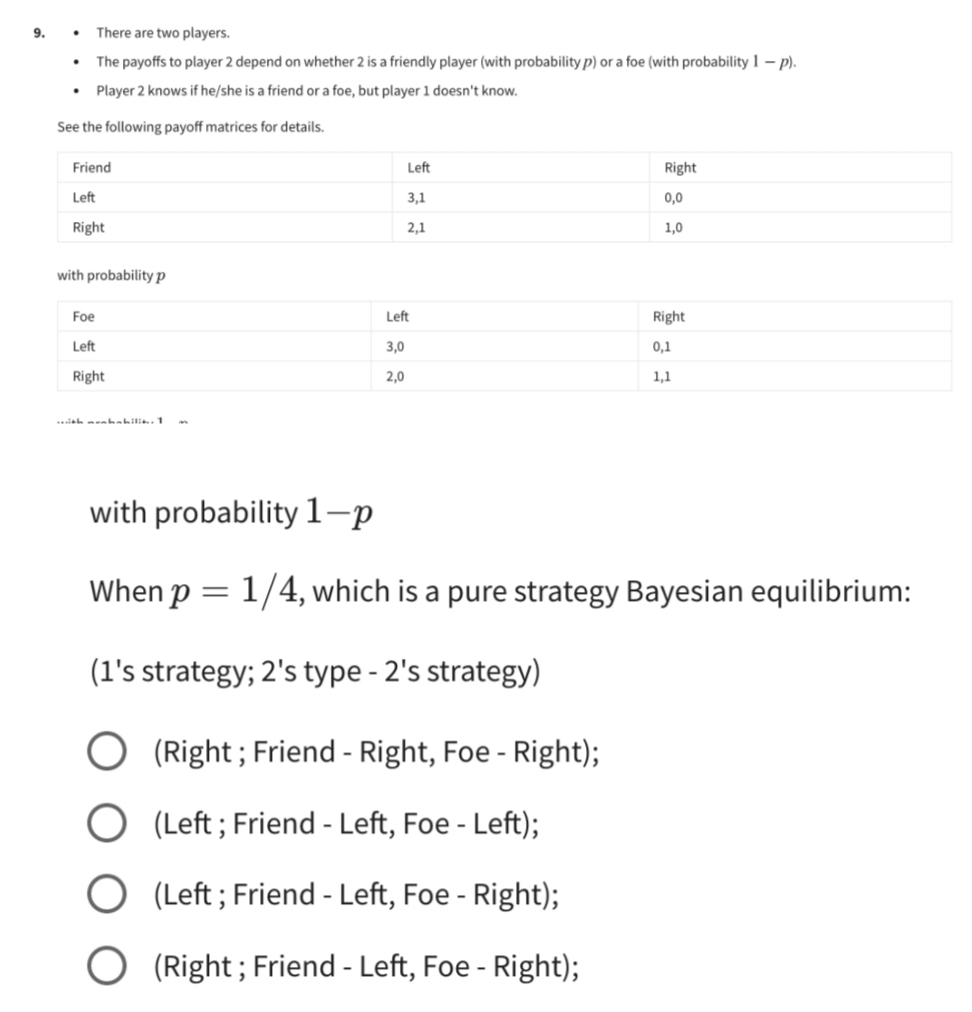9. . There are two players. . The payoffs to player 2 depend on whether 2 is a friendly player (with probability p) or a foe (with probability 1 - p). • Player 2 knows if he/she is a friend or a foe, but player 1 doesn't know. See the following payoff matrices for details. Friend Left Right Left 3,1 0,0 Right 2,1 1,0 with probability p Foe Right Left 0,1 Right 1,1 with muhabili. 1 with probability 1-p When p = 1/4, which is a pure strategy Bayesian equilibrium: (1's strategy; 2's type - 2's strategy) O (Right; Friend - Right, Foe - Right); O (Left; Friend - Left, Foe - Left); O (Left; Friend - Left, Foe - Right); (Right; Friend - Left, Foe - Right); Left 3,0 2,0
9. . There are two players. . The payoffs to player 2 depend on whether 2 is a friendly player (with probability p) or a foe (with probability 1 - p). • Player 2 knows if he/she is a friend or a foe, but player 1 doesn't know. See the following payoff matrices for details. Friend Left Right Left 3,1 0,0 Right 2,1 1,0 with probability p Foe Right Left 0,1 Right 1,1 with muhabili. 1 with probability 1-p When p = 1/4, which is a pure strategy Bayesian equilibrium: (1's strategy; 2's type - 2's strategy) O (Right; Friend - Right, Foe - Right); O (Left; Friend - Left, Foe - Left); O (Left; Friend - Left, Foe - Right); (Right; Friend - Left, Foe - Right); Left 3,0 2,0
Chapter7: Uncertainty
Section: Chapter Questions
Problem 7.3P
Related questions
Question
2

Transcribed Image Text:9.
There are two players.
The payoffs to player 2 depend on whether 2 is a friendly player (with probability p) or a foe (with probability 1 - p).
• Player 2 knows if he/she is a friend or a foe, but player 1 doesn't know.
See the following payoff matrices for details.
Friend
Left
Right
Left
3,1
0,0
Right
2,1
1,0
with probability p
Foe
Right
Left
0,1
Right
1,1
with muhabilit. 1
with probability 1-p
When p = 1/4, which is a pure strategy Bayesian equilibrium:
(1's strategy; 2's type - 2's strategy)
O (Right; Friend - Right, Foe - Right);
O (Left; Friend - Left, Foe - Left);
O (Left; Friend - Left, Foe - Right);
(Right; Friend - Left, Foe - Right);
.
Left
3,0
2,0
Expert Solution
This question has been solved!
Explore an expertly crafted, step-by-step solution for a thorough understanding of key concepts.
This is a popular solution!
Trending now
This is a popular solution!
Step by step
Solved in 2 steps

Knowledge Booster
Learn more about
Need a deep-dive on the concept behind this application? Look no further. Learn more about this topic, economics and related others by exploring similar questions and additional content below.Recommended textbooks for you


Managerial Economics: A Problem Solving Approach
Economics
ISBN:
9781337106665
Author:
Luke M. Froeb, Brian T. McCann, Michael R. Ward, Mike Shor
Publisher:
Cengage Learning


Managerial Economics: A Problem Solving Approach
Economics
ISBN:
9781337106665
Author:
Luke M. Froeb, Brian T. McCann, Michael R. Ward, Mike Shor
Publisher:
Cengage Learning